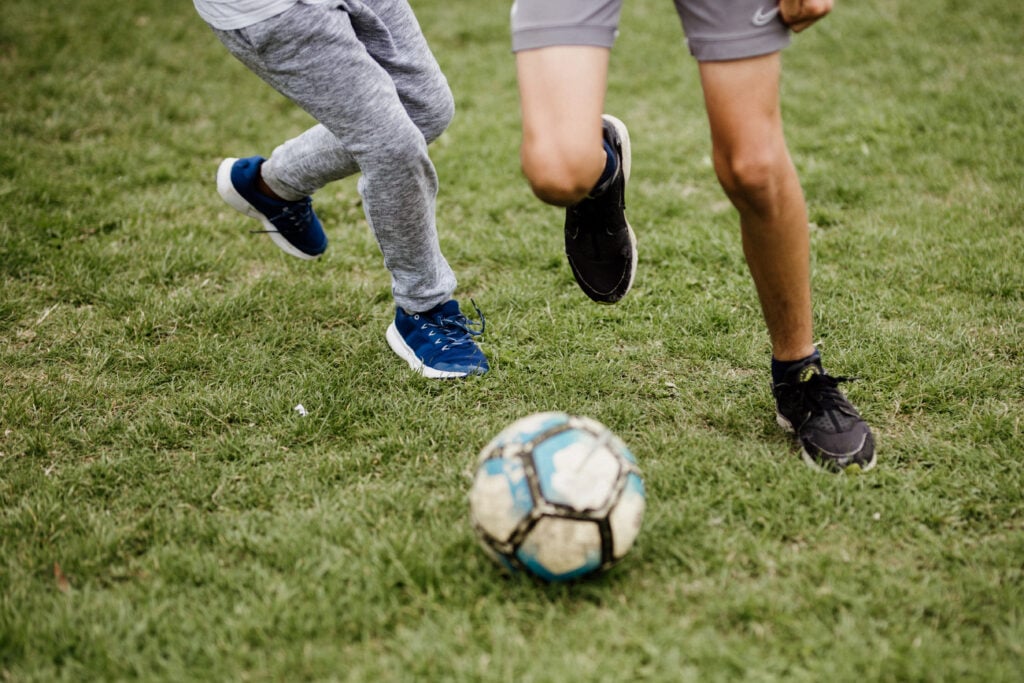
Written by Joe Godwood & Joe Keohane, StreetGames Research & Insights Team
Sport England recently released the latest results from the Active Lives Children and Young People Survey, providing a comprehensive look into the state of physical activity among the younger generation. Published on December 7th, the report explores the overall participation in different sports and physical activity types, as well as the attitudes of children and young people towards staying active.
Whilst the survey shows that activity levels have increased in general, it also makes clear that the divide between the most and least affluent families continues to grow. More worryingly still, happiness levels amongst young people have gone down across the board, with children from the least affluent families faring worst of all.
Survey results show that 47% of young people are ‘active’- meeting the Chief Medical Officer’s (CMO) guidelines by participating in moderately vigorous physical activity for an average of 60 minutes a day. A further 22.8% are rated as ‘fairly active’ while 30.2% are categorised as ‘less active’ with less than 30 minutes a day on average. Encouragingly, the data from the 2022/23 academic year shows stability compared to the previous 12 months, signalling a sustained recovery in participation post-pandemic. Within this generally positive trend however, there are also causes for concern.
Activity Levels & Affluence:
One standout aspect is the disparity in activity levels among children and young people from different socio-economic backgrounds. The report indicates that those from the least affluent families are the least likely to meet the CMO guidelines, with only 44% reaching the recommended activity levels compared to 55% from more affluent families.
While the proportion of children and young people from low affluence families who are active has increased from 42% to 44% over the past 12 months, a larger increase was observed in high affluence families (52% to 55%). This results in a widening gap from 10% to 11% between high and low affluence.
Decrease in Inactivity: The proportion of inactive children and young people from low affluence families has decreased from 36% to 34% over the past year, mirroring a similar drop in high affluence families (25% to 23%). Despite the positive trend, the gap between inactive high and low affluence children and young people remains unchanged at 11%.
Beyond participation in sport and physical activity, the survey also delves into the mental well-being of young people, considering factors like happiness, life satisfaction and feeling worthwhile:

Happiness: Whilst there have been significant decreases in the score reported across all income groups, the biggest decrease can be seen in those children and young people from low affluence households, compared to baseline data.

Life Satisfaction: Children and young people from low affluence households have reported a decrease in life satisfaction scores since baseline data, while those from high affluence households show an increase (though not statistically significant).

Worthwhile: A notable decrease in scores regarding feeling worthwhile is reported among children from low affluence households, in stark contrast to a significant increase observed in their high-affluence counterparts since baseline data.
Involvement in sport can extend beyond taking part as a participant; it also provides opportunities to volunteer and to attend live sporting events, which both bring their own benefits. Noticeable disparities persist in the rates of volunteering and spectating between children and young people from lower and higher affluence backgrounds.

Volunteering: The survey reveals a significant 20.7% gap in volunteering rates to support exercise and sports between children from low and high affluence households. Worryingly, a significant decrease in volunteering rates can be seen across all income groups.

Spectating: Attendance at live sports events is notably lower among children from low affluence households compared to those from high affluence households who have seen a significant increase in the rate of attending live sporting events, emphasising disparities in access and engagement.
While the Active Lives Children and Young People Survey presents positive trends in overall activity levels, it also uncovers areas of concern, particularly regarding socio-economic disparities and their impact on the well-being of young people. Acknowledging these nuances is crucial for designing targeted interventions that ensure every child, regardless of background, has equal access to an active and fulfilling lifestyle.
The Sport England Together Fund (TF) serves as a really great example of how targeted interventions can play a role in addressing the disparities highlighted above. During the 2022-23 period, 104 Locally Trusted Organisations (LTOs) within the StreetGames network benefited from TF investment. This financial support played a crucial role in empowering LTOs to extend a diverse range of sport, physical activity, and engagement opportunities to young people living in low affluence, underserved communities.
The funding enabled LTOs across all regions of England to lead impactful community initiatives, designed to offer young people chances to engage in various sports, explore new activities, connect with diverse peer groups and foster excitement during major sporting events held throughout 2022-23.
A total of 8,746 young people actively participated in these initiatives – comprising 40% females, 46% from ethnically diverse communities, 5% disabled and 6% living with a long-term health condition.
Feedback, from a sample of these participants, highlighted the benefits they experienced, many of which align with the challenges identified in the Active Lives data:
From the participants who provided feedback, 61% stated that the fund helped them try new activities, 58% reported an increase in confidence to be active, 56% felt it had improved management of their physical health, and 49% acknowledged engaging in more activity than they would have without the project.
39% of participants noted that the project assisted them in managing their mental health. The social dimension of the projects played a pivotal role, with time spent with friends and the formation of new connections emerging as primary sources of enjoyment. The enjoyable and fun nature of the sessions was highlighted as a key motivator, encouraging regular attendance.
“This activity has drastically improved my mental health and kept me out of other unbeneficial activities, making great use of my time. I think more activities like this should be pushed into action.”
The sport sessions were also viewed as opportunities for personal development, allowing participants to improve communication skills, health, leadership skills, and confidence. Many LTOs offered participants the opportunity to volunteer and undertake placements, which they saw as rare opportunities:
“I have never had any support like this before and never got placements elsewhere because they always say they are full.”
All TF funded LTOs received support and guidance to provide young people with opportunities to celebrate, get involved, and feel the ‘ripple effect’ of major sporting events through a broader StreetGames campaign called #Inspiration. Many projects took young people to watch live sports events and aligned sessions and festivals with major sport events to generate excitement among participants.
Feedback from LTOs underscored the impact of this funding on their ability to support the engagement of young people from low-income underserved communities in regular sport and physical activity. LTOs felt the intervention had most notably helped increase opportunities for people to be active (95%), provided the wider community with more opportunities to be active (89%), instilled more confidence in the local community to be active (82%), and assisted the local community in managing their physical health (81%). For 81% of the funded LTOs the TF investment was rated extremely important in helping their organisation to continue to exist and in supporting more young people to be active.
The data above highlights the crucial role such funding plays in reducing the disparity between young people from low-affluence families and high-affluence families highlighted in the Active Lives data – particularly in the current economic climate where rises in the cost of living mean that many young people and their families have very little disposable income and many community sports organisations are facing increased running costs. While Sport England’s multi-year commitment to £250 million additional investment in Place, targeted at areas of greatest need, is hugely welcome, there remains a clear and pressing need for immediate funding to support LTOs delivering on the ground today to enable more young people to be active right now.
At StreetGames one of our key roles involves sign-posting and supporting LTOs to access funding to support their doorstep sport activities, and whilst there have been many notable successes in the past year (e.g. via the NCLF- Million Hours fund, VRUs and HAF) – the majority of the funding sourced, has come from non-sports sources, which often come with very specific non-sport eligibility criteria.
With a General Election on the horizon, there are genuine risks that funding to support vital sporting infrastructure in low-income communities will not be available swiftly enough at a crucial time.

